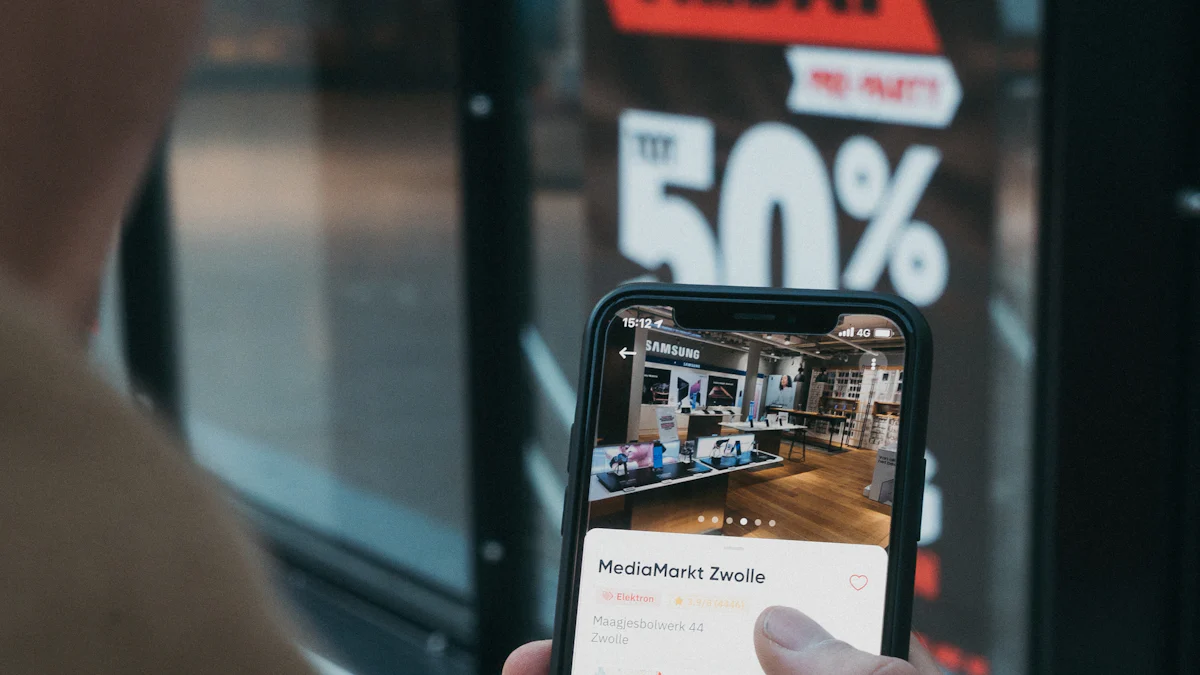9 Proven Strategies to Make Your Online Store Shine

Standing out as an online seller can feel like an uphill battle. With over 12 to 24 million eCommerce stores worldwide, competition is fierce. Customers have endless options, and grabbing their attention requires more than just good products. You need strategies that make your store visible and memorable. The good news? Success is within reach. By taking the right steps, you can carve out your space in this booming industry, where eCommerce now accounts for 16% of total U.S. retail sales. It’s time to make your store shine and attract the audience it deserves.
Key Takeaways
Create a professional, mobile-friendly website to make a strong first impression and enhance user experience.
Optimize your site for SEO by using relevant keywords in product descriptions and blog posts to attract organic traffic.
Develop a strong brand identity with a memorable logo and a compelling brand story to connect with your audience.
Leverage social media by focusing on platforms where your target audience is active and posting engaging content consistently.
Utilize content marketing by writing helpful articles that address customer questions, establishing your authority in your niche.
Engage with customers through prompt responses and personalized email marketing to build trust and loyalty.
Implement promotions and loyalty programs to incentivize purchases and reward repeat customers, driving sales and engagement.
Building Your Online Presence as an Online Seller

Creating a strong online presence is the foundation of success for any online seller. Your website serves as your storefront, your brand’s identity, and your primary tool to get your business noticed. Let’s explore how you can build a professional, user-friendly platform and use effective strategies to increase your business's visibility.
Create a Professional and User-Friendly Website
Your website is often the first impression customers have of your business. A poorly designed or slow-loading site can drive traffic away before visitors even explore your products. To ensure your website stands out, focus on these key areas:
Optimize for mobile users.
More than half of online shoppers use their smartphones to browse and make purchases. If your website isn’t mobile-friendly, you risk losing a significant portion of potential customers. Use responsive design to ensure your site adapts seamlessly to any screen size. Test your website on various devices to confirm that images, buttons, and text display correctly. A smooth mobile experience can help grow your audience and boost conversions.
Ensure fast loading times and easy navigation.
Speed matters. Studies show that nearly 70% of consumers abandon websites that take too long to load. Aim for a loading time of under three seconds to keep visitors engaged. Compress images, minimize unnecessary plugins, and use a reliable hosting service to improve performance. Additionally, make navigation intuitive. Organize your categories clearly, add a search bar, and ensure that checkout is hassle-free. A fast, user-friendly website builds trust and encourages repeat visits.
Invest in Search Engine Optimization (SEO) to Increase Your Business's Visibility
Search engine optimization is one of the most effective ways to market your business and get noticed online. By optimizing your website for SEO, you can rank higher in search results and attract more organic traffic.
Use relevant keywords in product descriptions and blog posts.
Keywords are the backbone of SEO. Research terms your target audience searches for and incorporate them naturally into your product descriptions, titles, and blog content. For example, if you sell handmade candles, phrases like “eco-friendly candles” or “soy wax candles” can help your site appear in relevant searches. Avoid keyword stuffing, as it can harm your rankings and readability.
Leverage tools like Google Keyword Planner or SEMrush.
SEO tools simplify the process of finding high-performing keywords and analyzing your competition. Platforms like Google Keyword Planner and SEMrush provide insights into search volume, trends, and keyword difficulty. Use these tools to refine your strategy and focus on terms that align with your niche. Consistent optimization will help drive traffic and increase awareness of your store.
Develop a Strong Brand Identity to Market Your Business
Your brand is more than just a logo; it’s the story and personality behind your business. A strong brand identity helps you stand out and connect with your audience on a deeper level.
Design a memorable logo and consistent color scheme.
Visual elements play a crucial role in how customers perceive your business. Create a logo that reflects your values and resonates with your target audience. Stick to a consistent color palette and typography across your website, packaging, and social media. Consistency builds recognition and reinforces your brand’s professionalism.
Craft a compelling brand story that resonates with your audience.
Every small business has a unique story. Share yours to create an emotional connection with your customers. Explain why you started your business, what makes your products special, and how you aim to solve your customers’ problems. A relatable and authentic story can inspire loyalty and encourage word-of-mouth marketing.
By focusing on these strategies, you can promote your business effectively and lay the groundwork for long-term success. A professional website, strong SEO practices, and a memorable brand identity will help you get your business noticed and grow your audience.
Leveraging Social Media and Content to Get Your Business Noticed

Social media and content creation are powerful tools to help you promote your business and grow your audience. By using these platforms effectively, you can attract followers, build trust, and drive traffic to your website. Let’s dive into actionable marketing tips that will help you stand out.
Build a Social Media Presence
Social media marketing is one of the best ways to market your business and connect with potential customers. To make the most of it, focus on the platforms that align with your audience and goals.
Focus on platforms where your target audience spends time.
Not all social media platforms are created equal. Research where your ideal customers hang out. For instance, Instagram works well for visually-driven brands, while LinkedIn suits professional services. Once you identify the right platform, tailor your content to match its style. For example, ASOS uses Instagram to showcase high-quality visuals of their products, often paired with interactive features like polls and quizzes. This approach keeps their audience engaged and boosts awareness.
Post engaging content consistently, such as product demos or behind-the-scenes videos.
Consistency is key to attracting and retaining followers. Share a mix of content that entertains, educates, and inspires. Product demos, tutorials, and behind-the-scenes glimpses of your small business can humanize your brand and build trust. BarkBox’s #DanceForYourDog campaign is a great example of how creative content can drive engagement. Encourage your followers to participate in fun challenges or share user-generated content to amplify your reach.
Start a Blog or Content Marketing Strategy
Content marketing is an excellent way to establish authority in your niche and drive organic traffic to your website. A well-maintained blog can also help you connect with your audience on a deeper level.
Write helpful articles related to your niche to attract organic traffic.
Think about the questions your customers often ask and create blog posts that answer them. For example, if you sell skincare products, write articles about skincare routines or ingredient benefits. This not only helps your audience but also improves your SEO, making it easier for people to find your website. Valuable content positions you as an expert and builds trust with your readers.
Share tips, tutorials, or industry insights to establish authority.
Go beyond basic articles. Share actionable tips, step-by-step tutorials, or insights into industry trends. For instance, a beauty brand might collaborate with influencers to create authentic stories about their products. These stories resonate with shoppers and enhance your credibility. By offering useful information, you can attract followers and keep them coming back for more.
Use Paid Advertising Strategically to Market Your Business
Paid advertising can give your online seller journey a significant boost. When done right, it helps you reach a larger audience and drive traffic to your website.
Run targeted ads on platforms like Facebook, Instagram, or Google.
Targeted ads allow you to focus on specific demographics, interests, or behaviors. For example, if you sell fitness gear, you can target ads to people interested in health and wellness. Platforms like Facebook and Instagram offer robust tools to refine your audience. This ensures your ads reach the right people, increasing the chances of conversions.
Test different ad formats and track performance metrics.
Experimentation is crucial in paid marketing. Try various ad formats, such as carousel ads, video ads, or sponsored posts, to see what resonates with your audience. Track metrics like click-through rates, conversions, and return on investment to measure success. Adjust your strategy based on the data to maximize results. For instance, Tin Pot Creamery used online ads to expand their reach beyond physical stores, proving how effective digital marketing can be for small businesses.
By leveraging social media and content marketing, you can promote your business, attract followers, and grow your audience. Whether you’re sharing engaging posts, writing helpful blogs, or running targeted ads, these strategies will help you drive traffic and build lasting connections with your customers.
Collaborating and Engaging to Increase Your Business's Visibility
Collaboration and engagement are powerful tools to help you promote your business and connect with your audience. By working with others and building meaningful relationships, you can increase exposure, grow your audience, and create a loyal customer base. Let’s explore how you can use partnerships, customer interactions, and incentives to market your business effectively.
Partner with Influencers or Affiliates
Influencers and affiliates can help you reach new audiences and build trust for your brand. Their authentic endorsements often resonate more with potential customers than traditional ads.
Collaborate with micro-influencers in your niche for authentic promotion.
Micro-influencers, with their smaller but highly engaged follower base, can be a game-changer for your small business. They often have a closer connection with their followers, making their recommendations feel genuine. For example, Dyson successfully used Instagram influencers to boost product awareness. By partnering with influencers who aligned with their brand values, they reached a wider audience while maintaining authenticity. You can do the same by offering free samples or incentives to influencers in your niche. Encourage them to share their honest experiences with your products in a way that feels natural to their audience.
Offer affiliate programs to incentivize others to promote your products.
Affiliate programs are a win-win for you and your partners. Affiliates earn a commission for every sale they drive, while you benefit from increased website traffic and sales. This strategy works particularly well for online sellers looking to expand their reach without upfront costs. Provide your affiliates with marketing materials like banners, links, or product images to make it easy for them to promote your business. A well-structured affiliate program can help you tap into new markets and build long-term partnerships.
Engage with Your Customers
Building strong relationships with your customers is essential for long-term success. When you engage with customers effectively, you create trust and loyalty that keeps them coming back.
Respond promptly to customer inquiries and feedback.
Quick responses show your customers that you value their time and opinions. Whether it’s a question about a product or feedback on their experience, addressing their concerns promptly can leave a lasting impression. Use tools like chatbots or email automation to ensure no message goes unanswered. Engaging with your customers in this way not only builds trust but also encourages positive word-of-mouth marketing.
Use email marketing to nurture relationships and share updates.
Email marketing remains one of the most effective ways to market your business. Regular newsletters can keep your audience informed about new products, promotions, or updates. Personalize your emails to make your customers feel valued. For instance, send a thank-you email after a purchase or recommend products based on their browsing history. This approach helps you stay top of mind and drive traffic back to your website.
Offer Promotions and Incentives to Get Your Business Noticed
Promotions and incentives can create excitement around your brand and encourage customers to take action. These strategies not only attract new customers but also reward loyal ones.
Run limited-time discounts or free shipping offers.
Limited-time offers create a sense of urgency that motivates customers to act quickly. For example, a “24-hour flash sale” or “free shipping on orders over $50” can significantly boost sales. Highlight these promotions on your website and social media channels to maximize their reach. These tactics not only increase website traffic but also help you clear out inventory and attract new buyers.
Create loyalty programs to reward repeat customers.
Loyalty programs are a great way to retain customers and encourage repeat purchases. Offer points for every dollar spent, which can be redeemed for discounts or free products. You could also provide exclusive perks like early access to sales or special gifts for members. A well-designed loyalty program makes your customers feel appreciated and strengthens their connection to your brand.
By collaborating with influencers, engaging directly with your customers, and offering enticing promotions, you can effectively market your business and increase awareness. These strategies will help you build lasting relationships, drive traffic to your website, and grow your audience over time.
Standing out as an online seller in today’s competitive market requires focus and persistence. By implementing these strategies step by step, you can build a strong foundation for your small business. Start with one area, like improving your website or engaging with customers, and track your progress. Consistency is key. Adjust your approach based on what works best for your audience, and don’t forget to celebrate small wins along the way. Success doesn’t happen overnight, but with dedication, your store can shine and attract loyal customers.
FAQ
Why is an FAQ page important for your eCommerce store?
An FAQ page plays a crucial role in enhancing your eCommerce store. It provides quick answers to common questions, saving your customers time and reducing frustration. By addressing potential concerns upfront, you guide visitors toward confident purchase decisions. Plus, an FAQ page improves your website’s searchability, helping you attract more traffic and stand out in the competitive eCommerce market.
Pro Tip: A well-crafted FAQ page not only supports your customers but also reduces the workload on your customer service team.
How do I create an effective FAQ page?
Start by identifying the most common questions your customers ask. Use clear, concise language to answer these questions. Organize the content into categories for easy navigation. Include keywords relevant to your eCommerce niche to boost SEO. Regularly update the page to reflect new policies, products, or customer feedback. A simple, user-friendly design ensures your FAQ page remains accessible and helpful.
What should I include in my FAQ page?
Your FAQ page should cover essential topics like shipping, returns, payment methods, and product details. Address any unique aspects of your eCommerce business, such as sustainability practices or customization options. Don’t forget to include a section about your return and exchange process. This reassures customers and builds trust in your brand.
How can an FAQ page improve customer satisfaction?
An FAQ page empowers your customers by providing instant answers to their questions. It eliminates the need to wait for a response from customer support. This convenience enhances their shopping experience and builds loyalty. When customers feel informed and valued, they’re more likely to complete their purchases and return to your store.
How do I handle returns and exchanges on my eCommerce website?
Create a dedicated section on your FAQ page to explain your return and exchange process. Use straightforward language to outline the steps customers need to follow. Include details like timeframes, conditions, and how refunds are processed. Transparency in this area reduces confusion and fosters trust with your customers.
Can an FAQ page help with SEO?
Yes, an FAQ page can significantly boost your eCommerce store’s SEO. By including relevant keywords in your questions and answers, you increase the chances of appearing in search engine results. Search engines value content that directly addresses user queries. A well-optimized FAQ page attracts organic traffic and improves your site’s visibility.
How often should I update my FAQ page?
You should update your FAQ page whenever there are changes to your policies, products, or services. Regular updates ensure the information remains accurate and relevant. Monitor customer inquiries to identify new questions that need to be added. Keeping your FAQ page current shows your commitment to providing excellent service.
Should I use visuals on my FAQ page?
Yes, visuals can make your FAQ page more engaging and easier to understand. Use images, icons, or videos to explain complex processes like assembling a product or navigating your website. Visual aids enhance clarity and improve the overall user experience, especially for customers who prefer visual learning.
How do I measure the effectiveness of my FAQ page?
Track metrics like page views, time spent on the page, and bounce rates to evaluate your FAQ page’s performance. Analyze customer feedback to identify areas for improvement. If you notice a decrease in repetitive inquiries to your support team, it’s a sign that your FAQ page is doing its job effectively.
Can an FAQ page reduce cart abandonment?
Absolutely! An FAQ page addresses common concerns that might prevent customers from completing their purchases. Questions about shipping costs, delivery times, or payment security often cause hesitation. By providing clear answers, you eliminate doubts and encourage customers to proceed with their orders.
See Also
Smart Marketing Approaches For Your Flashlight Wholesale Venture
Essential Advice For Sourcing Camping Lights To Boost Profits
Key Strategies For Sourcing Wholesale Flashlights Effectively
